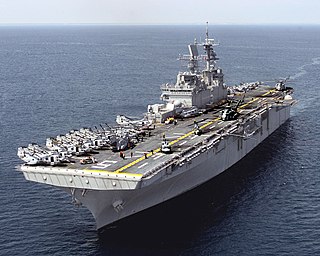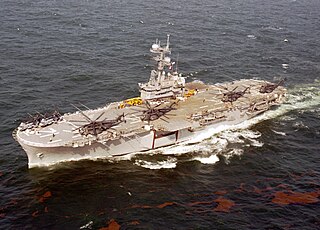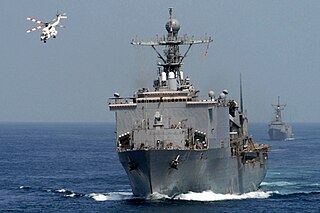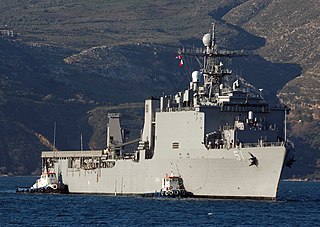
USS Dwight D. Eisenhower (CVN-69) is a nuclear-powered aircraft carrier currently in service with the United States Navy. Commissioned in 1977, the ship is the second of ten Nimitz-class aircraft carriers currently in service, and is the first ship named after the 34th President of the United States and General of the Army, Dwight D. Eisenhower. The vessel was initially named simply as USS Eisenhower, much like the lead ship of the class, Nimitz, but the name was changed to its present form on 25 May 1970. The carrier, like all others of her class, was constructed at Newport News Shipbuilding Company in Virginia, with the same design as the lead ship, although the ship has been overhauled twice to bring her up to the standards of those constructed more recently.

USS New Orleans (LPD-18), a San Antonio-class amphibious transport dock, is the fourth commissioned ship of the United States Navy to be named after the city of New Orleans, Louisiana.

The Fifth Fleet is a numbered fleet of the United States Navy. Its area of responsibility encompasses approximately 2.5 million square miles, and includes the Persian Gulf, Red Sea, Arabian Sea, and parts of the Indian Ocean. It shares a commander and headquarters with U.S. Naval Forces Central Command (NAVCENT) in Bahrain. Fifth Fleet/NAVCENT is a component command of, and reports to, U.S. Central Command (CENTCOM).

USS Mississippi (CGN-40), a Virginia-class nuclear-powered guided-missile cruiser, was the fourth ship of the United States Navy named in honor of the 20th state admitted to the Union. Her keel was laid down by the Newport News Shipbuilding and Drydock Company at Newport News, Virginia, on 22 February 1975. She was launched on 31 July 1976. The ship was commissioned on 5 August 1978 by Jimmy Carter, then serving as the 39th president of the United States. Early deployment included escorting the carrier USS Nimitz (CVN-68). She also was deployed in 1989 as a response to the capture and subsequent murder of U.S. Marine Corps Colonel William R. Higgins by terrorists.

USS Bataan (LHD-5) is a Wasp-class amphibious assault ship in the United States Navy. The ship is named after the Battle of Bataan, fought in the Philippines during World War II. The ship enables the U.S. Navy and U.S. Marine Corps team to seamlessly transition from the sea to a land battle, as the lead ship and centerpiece of an Amphibious Ready Group. She is capable of amphibious assault, advance force, and special purpose operations, as well as evacuation and humanitarian assistance. The ship effected the 2020 targeted killing of Iranian Major General Qasem Soleimani of the Islamic Revolutionary Guard Corps, the commander of the Quds Force, which is designated a terrorist organization by the United States.

USS Farragut (DDG-99) is an Arleigh Burke-class destroyer in the United States Navy. She is the fifth Navy ship named for Admiral David Farragut (1801–1870), and the 49th ship of the Arleigh Burke class.

USS Nassau (LHA-4) was a Tarawa-class amphibious assault ship. When active, she was capable of transporting more than 3,000 United States Navy and United States Marine Corps personnel. Ingalls Shipbuilding in Pascagoula, Mississippi, laid the ship's keel on 13 August 1973; she was commissioned on 28 July 1979. She was decommissioned on 31 March 2011.

USS Inchon (LPH/MCS-12) was an Iwo Jima-class amphibious assault ship of the United States Navy in service from 1970 to 2002. Following a major fire, she was laid up and sunk as a target in 2004.

USS Whidbey Island (LSD-41) is a Whidbey Island-class dock landing ship (LSD) of the United States Navy. She was named for Whidbey Island, in Puget Sound, Washington, the location of NAS Whidbey Island; the name ultimately derives from the sailor, explorer and engineer Joseph Whidbey.

USS Oak Hill (LSD-51) is a Harpers Ferry-class dock landing ship of the United States Navy. She is named in honor of Oak Hill, the residence of James Monroe, the fifth president of the United States. The Monroe Doctrine was penned at Oak Hill, and subsequently delivered at an 1823 congressional address which asserted that the Western Hemisphere was never to be colonized again. This doctrine is the inspiration for the ship's motto: Nations' Protector. Oak Hill is the second ship to honor the residence.

USS Taconic (AGC-17/LCC-17) was an Adirondack class amphibious force command ship of the U.S. Navy named after the Taconic Mountains in New York. She was laid down in December 1944 and decommissioned in January 1969.

HSC-7 Helicopter Sea Combat Squadron Seven, also known as the Dusty Dogs, is a United States Navy helicopter squadron located at Naval Station Norfolk. They are attached to Carrier Air Wing Three and deploy aboard USS Dwight D. Eisenhower.

USS Firebolt (PC-10) is the 10th member of the Cyclone class of coastal patrol boats of the United States Navy. She is a 174 ft (53 m) vessel with a crew of approximately 30 sailors, normally homeported at Naval Amphibious Base Little Creek, Norfolk, Virginia. Her armament includes two Mk38 chain guns, two Mk19 automatic grenade launchers, and two .50 in (12.7 mm) machine guns, as well as six Stinger missiles. She was laid down by Bollinger Shipyards on 17 September 1993, launched on 10 June 1994, commissioned into the Navy on 10 June 1995, and she was decommissioned on 23 February 2022.

The Cyclone-class patrol ships are a class of coastal patrol boats, formerly in service with the United States Navy. Most of these ships, named for weather phenomenae, were launched between 1992 and 1994. The primary mission of these ships is coastal patrol and interdiction surveillance, an important aspect of littoral operations outlined in the Navy's strategy, "Forward...From the Sea." These ships also provided full mission support for U.S. Navy SEALs and other special operations forces. Several ships of the class were transferred to the U.S. Coast Guard (USCG) for a time and then later returned.

USS Tempest (PC-2) is the second of the Cyclone-class of United States Navy coastal patrol ships, named for various weather phenomena. She was transferred to the US Coast Guard as USCGC Tempest (WPC-2), on 1 October 2004, and placed in 'Commission Special' status until December 2005, when she was formally commissioned as a Coast Guard cutter. She was returned to the US Navy on 22 August 2008.

USS Typhoon (PC-5) is the fifth United States Navy Cyclone-class patrol ship. Typhoon was laid down 15 May 1992 at Bollinger Shipyards, in Lockport, Louisiana and launched 3 March 1993. She was commissioned 12 February 1994 in Tampa, Florida. As of 2008, Typhoon operates in the Persian Gulf, stationed in Manama, Bahrain since 2004 and is permanently crewed by a 24-person complement that performs maritime security operations in United States Fifth Fleet Area of Responsibility (AOR).

USS Sirocco (PC-6) is the sixth Cyclone-class patrol ship of the U.S. Navy. Sirocco was laid down 20 June 1992 by Bollinger Shipyards in Lockport, Louisiana. The ship was launched 29 May 1993, and sponsored by Mrs. Kathleen Smith, wife of RADM Raymond C. Smith, Commander, Naval Special Warfare Command. She was commissioned by the Navy 11 June 1994. As of 2016, the ship was stationed in Bahrain performing coastal patrol and interdiction surveillance in the region. She was decommissioned on 20 March 2023.

Expeditionary Strike Group SEVEN/Task Force 76 is a United States Navy task force. It is part of the United States Seventh Fleet and the USN's only permanently forward-deployed expeditionary strike group. It is based at the White Beach Naval Facility at the end of the Katsuren Peninsula in Uruma City, Okinawa, Japan.

Destroyer Squadron 50 is a destroyer squadron of the United States Navy. The squadron was first formed during World War II when the squadron commodore and his staff led ships in the Pacific Theater from October 1943 until its disestablishment in November 1945. The squadron was equipped with nine Fletcher-class destroyers, comprising Destroyer Divisions (DesDivs) 99 and 100.




















